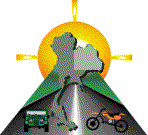|
Early cultures See eastern map. The excavations
at Ban Chieng and Ban Prasat tell the story of an early people in the northeastern
area of Thailand. Evidence suggests that the first known advanced cultures migrated
into the fertile Sakhon Nakhon Basin in the North near Udon and the Ban Chieng site,
then, presumably, moved south to another fertile area in the Korat Basin near
Nakhon Ratchasima and the Ban Prasat site.
|
|
Ban Chieng At Ban Chieng is found an early agriculture based culture possibly
more than 4,000 years old that had developed a distinctive style of pottery that is
comparable to other areas throughout the East. Later they developed into a bronze
era that is arguably around 3,000 years old. This is contemporary with that of China,
and a point of contention about whose bronze age came first. The Bronze age Ban Chieng
culture produced bronze tools such as axes and also fine bronze jewelry.
|
 Phu Phra Bat Historical
Park - Wat Pho Sri Nai museum (hours: 9-4, Closed Mon & Tue). The Buddhist
temple of the odd geological rock formations and prehistoric cave paintings of Pra
Phu, combined with people and animals at Tha Bat Bok make for an
interesting morning or afternoon side trip. This area, has long been revered as sacred
from the prehistoric age throughout the Dhavaravadi era and including present times. It
has also been the inspiration of the folk tale "Nang Ousa and Tao Baros."
At the entrance to the historical park is a museum that will supply a map to guide you
through the geological formations and to the rock paintings. Two to three hours of easy
walking are needed to see everything. At Pha Taem near Kong Chiam there is
further evidence of rock paintings by prehistoric man that are high atop a cliff overlooking
the Mekong River. Phu Phra Bat Historical
Park - Wat Pho Sri Nai museum (hours: 9-4, Closed Mon & Tue). The Buddhist
temple of the odd geological rock formations and prehistoric cave paintings of Pra
Phu, combined with people and animals at Tha Bat Bok make for an
interesting morning or afternoon side trip. This area, has long been revered as sacred
from the prehistoric age throughout the Dhavaravadi era and including present times. It
has also been the inspiration of the folk tale "Nang Ousa and Tao Baros."
At the entrance to the historical park is a museum that will supply a map to guide you
through the geological formations and to the rock paintings. Two to three hours of easy
walking are needed to see everything. At Pha Taem near Kong Chiam there is
further evidence of rock paintings by prehistoric man that are high atop a cliff overlooking
the Mekong River.
|
|
THE KHMER EMPIRE The once vast Khmer Empire expanded into Thailand from Cambodia
where is best known for the Angor Wat temple complex. Scattered throughout Esan, or Eastern
Thailand, are the remains of Khmer temples constructed approximately 1000 to 1200 years ago.
There are over one hundred sites most being only a pile of rubble. At least ten sites are
worth seeing and many are either preserved or reconstructed by the Thailand Fine Arts
Department. These temples are similar in nature to the Khmer temples in Cambodia and are
constructed of laterite blocks, sculpted sandstone, and blue and pink slate. Exquisitely
carved sandstone lintels are often found over temple doorways. These temples reflect the
Khmer art in its pure form.
|
|
The Khmer Expedition This expedition is for those who are interested in learning about
archaeology firsthand and has been designed by the guides of the Northern Motor Club who have
repeatedly toured the area. This expedition is during the dry and temperate season and will be
leisurely and non-exertive to not exclude applicants. Alternate excursions for the more
athletically inclined will be arranged.
|
 Phu Phra Bat Historical
Park - Wat Pho Sri Nai museum (hours: 9-4, Closed Mon & Tue). The Buddhist
temple of the odd geological rock formations and prehistoric cave paintings of Pra
Phu, combined with people and animals at Tha Bat Bok make for an
interesting morning or afternoon side trip. This area, has long been revered as sacred
from the prehistoric age throughout the Dhavaravadi era and including present times. It
has also been the inspiration of the folk tale "Nang Ousa and Tao Baros."
At the entrance to the historical park is a museum that will supply a map to guide you
through the geological formations and to the rock paintings. Two to three hours of easy
walking are needed to see everything. At Pha Taem near Kong Chiam there is
further evidence of rock paintings by prehistoric man that are high atop a cliff overlooking
the Mekong River.
Phu Phra Bat Historical
Park - Wat Pho Sri Nai museum (hours: 9-4, Closed Mon & Tue). The Buddhist
temple of the odd geological rock formations and prehistoric cave paintings of Pra
Phu, combined with people and animals at Tha Bat Bok make for an
interesting morning or afternoon side trip. This area, has long been revered as sacred
from the prehistoric age throughout the Dhavaravadi era and including present times. It
has also been the inspiration of the folk tale "Nang Ousa and Tao Baros."
At the entrance to the historical park is a museum that will supply a map to guide you
through the geological formations and to the rock paintings. Two to three hours of easy
walking are needed to see everything. At Pha Taem near Kong Chiam there is
further evidence of rock paintings by prehistoric man that are high atop a cliff overlooking
the Mekong River.

